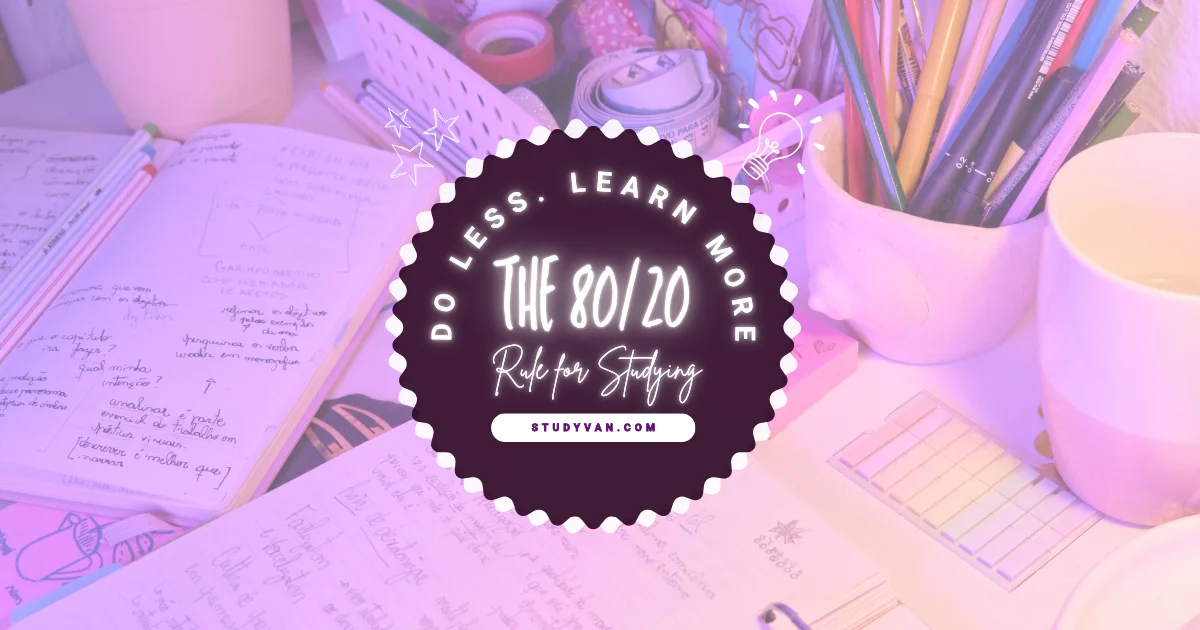
Do Less, Learn More: The 80/20 Rule for Studying
Most students waste time on low-impact study habits that don’t move the needle. The 80/20 rule flips the script: by focusing on the 20% of tasks that drive 80% of results, you can study smarter, cut hours, and still score higher. Here’s how.
Study Van
The Origins of the 80/20 Rule
Over a hundred years ago, Italian economist Vilfredo Pareto noticed something unusual. He found that 80% of the land in Italy was owned by just 20% of the people. As time went on, this pattern repeated across different areas of life 80% of wealth came from 20% of people, 80% of sales came from 20% of customers, and 80% of results came from only 20% of actions. This principle, now famously called the Pareto Principle or the 80/20 rule, is not just a piece of economic trivia. It’s a mindset shift, and when applied to studying, it can completely change how you learn.
What It Means for Students
If you’ve ever felt like you’re drowning in textbooks, notes, and endless hours of study but not getting much out of it, here’s the truth: most of your results are coming from a small fraction of your effort. The breakthrough moments, the concepts that finally “click” or the grades that push you forward, often emerge from the top 20% of your work. By identifying and focusing on these high-yield activities, you can trim away the wasted hours and concentrate on what truly counts.
The Trap of Low-Impact Studying
The problem is that most students fall into the trap of doing the opposite. Instead of leaning into the powerful 20%, they sink their time into low-impact tasks. Re-reading chapters again and again, highlighting lines in neon colors, or endlessly copy-pasting notes might feel like “studying,” but in reality, these tasks rarely move the needle. Being busy doesn’t mean being productive, and putting in more hours doesn’t always equal better progress.
Finding Your 20%
So how do you figure out where your 20% lies? Start by asking yourself a few questions before every study session. Which topics are most likely to show up on the exam? Which tasks actually deepen your understanding instead of just passing the time? Which methods give you noticeable progress in less time? The answers will point you toward the tasks that matter most the ones that deserve your full attention and protection, almost like treasure.
Doubling Down on What Works
Once you identify those high-impact methods, double down on them. Techniques like active recall, practicing with past exam questions, or teaching concepts out loud to yourself are proven to build stronger memory and deeper comprehension. Digital tools like streak tracking on Study Van can also keep you accountable and motivated, making sure your wins stack up day by day. When you cut out the fluff and chase mastery, your learning becomes sharper, faster, and more effective.
Building Your 80/20 Study Plan
One practical way to apply this principle is to create a tiered study plan. At the top are your high-impact tasks things like quizzing yourself, breaking down core concepts, and doing recall exercises. In the middle are medium-impact tasks, such as writing summaries or organizing notes. And finally, at the bottom are low-impact tasks like aesthetic prep or rereading. By scheduling your top-tier activities first, you ensure that the majority of your time is spent where it truly matters. The rest can wait until and only if you have extra time left.
The Takeaway
The 80/20 rule reminds us that you don’t need to do everything. You just need to do the right things. Instead of stretching yourself thin across endless busywork, focus on the 20% that delivers 80% of the gains. That’s where real progress is made. And if you need a little help, tools like Study Van are designed to bring everything into one calm hub timers, streaks, diaries, focus music — so you can stay locked in on the tasks that matter most. Less stress, less waste, more results. That’s the power of studying smarter, not longer.